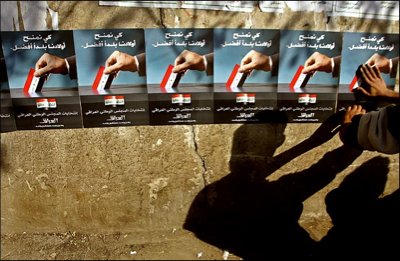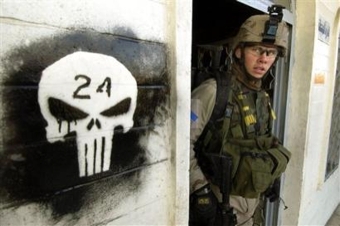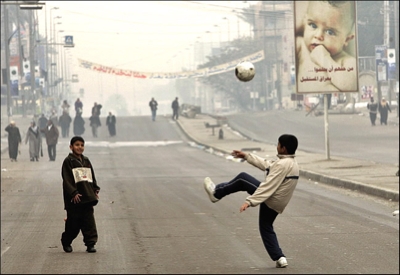Notes
Iraq Election Final: What's Up A Sleeve

(for a larger version, click here)
While hunting around this afternoon, it was nice to accidentally come upon a piece of photo analysis by someone else who is covering some of the same territory.
In an in depth analysis, Omar Khan took a look at this image which appeared on the front page of the NYTimes on January 13th. The photo shows someone affixing a string of identical election posters to a wall. The poster itself shows a hand placing an Iraqi flag into a ballot box. (This poster, by the way, has probably had more exposure on the newswires than any other Iraqi election graphic.) With the luxury of understanding the language, Khan interprets the writing above the hand as saying: "In order to give our children a better country." The other thing he picks up is the origin of that the shiny, stylized Iraqi flag (just below the level of the ballot box). Apparently, it is a logo of the American-installed Coalition Provisional Authority.
Because Khan takes a broader, more academic look at this photo then I would, I thought I would just skim some of the cream. As you’ll notice, he focuses on the mass produced quality of the image, and how much its slick appeal represents a technique of the powerful to sell an image of democracy, possibly in lieu of delivering the real goods.
These are three passages from Khan’s piece. (In a few spots, you’ll want to allow some leeway for his English).
–If the fingers are followed all the way to the wrist, what we see is a white cuff beneath a dark sleeve, an indication that this voter wears a business suit—denying, it would seem, to 70% of the Iraqi viewers of this poster the unemployment that has befallen them.
–The hand of the election worker touches (in fact overlaps with) the hand of the voter. But this likeness only accents the difference between the two photos, so unlike in every other respect. Contrast the Iraqi election worker’s hands (along the right edge, partly obscured, brown) with the hand in the poster (centered, posed, white); the natural light of day with the artificial lighting of the poster; and the tanned, pockmarked wall with the sheen of the ballot box and the silken, blue backdrop of a portrait studio. Is the photo in the New York Times, like the one it contains, also a self-evident product of the culture industry—in which technique has its basis in only "distribution and mechanical reproduction"? No: the photo, by showing the photo-poster within it, in fact exposes a product of the culture industry for what it is—nothing more than a piece of propaganda.
–We have a piece of mass-produced, CPA propaganda and an Iraqi who plasters it, repeatedly, to a wall. He places his right hand over that of the wealthy Iraqi voter, and sees through the propaganda he posters as surely as he sees his own hand. The photograph puts the meaning of the photo-poster—and the CPA and the US occupation that created it—on trial. The photo-poster seems little more than a charade, and one imposed from above at that. The obvious implication is that the same may be true of the elections. But we are not alone to worry about such things. The Iraqi man is with us. And he continues along—"resolute," the second caption tells us, in case the motion of his hand is somehow mistaken for a caress. [Note: I’m not sure where this caption appears. It might have been with the original printed photo.] Some meaning is restored to the poster (and, by implication, all that has created it) by an Iraqi. If the poster shows but a dream, then it is an Iraqi dream. It may be mass-produced, but it is Iraqi produced. It is in the name of Iraqi resoluteness, self-respect—indeed self-determination—that propaganda and occupation find some meaning.
Personally, after Kahn made reference to the cuff and sleeve, I got interested in that hand. Looking at the poster, you would have to agree that the suit (An Allawi type? Or, the convicted bank embezzler Chalabi? Or James Baker — who Bush quietly brought into the government then turned loose on the Iraqi financing structure?) has got a pretty firm grip on the country.
Despite his cynicism, Kahn’s identification with the man installing the poster gives him hope that Iraqi self-determination will overcome the occupation and its propaganda. What I’m not sure of, though, is whether the hand is just dangling the country over the ballot box, or it truly intends to let go.
(source: camerairaq. image: Marwan Naamani/Agence France-Presse — Getty Images in NYTimes)


Reactions
Comments Powered by Disqus